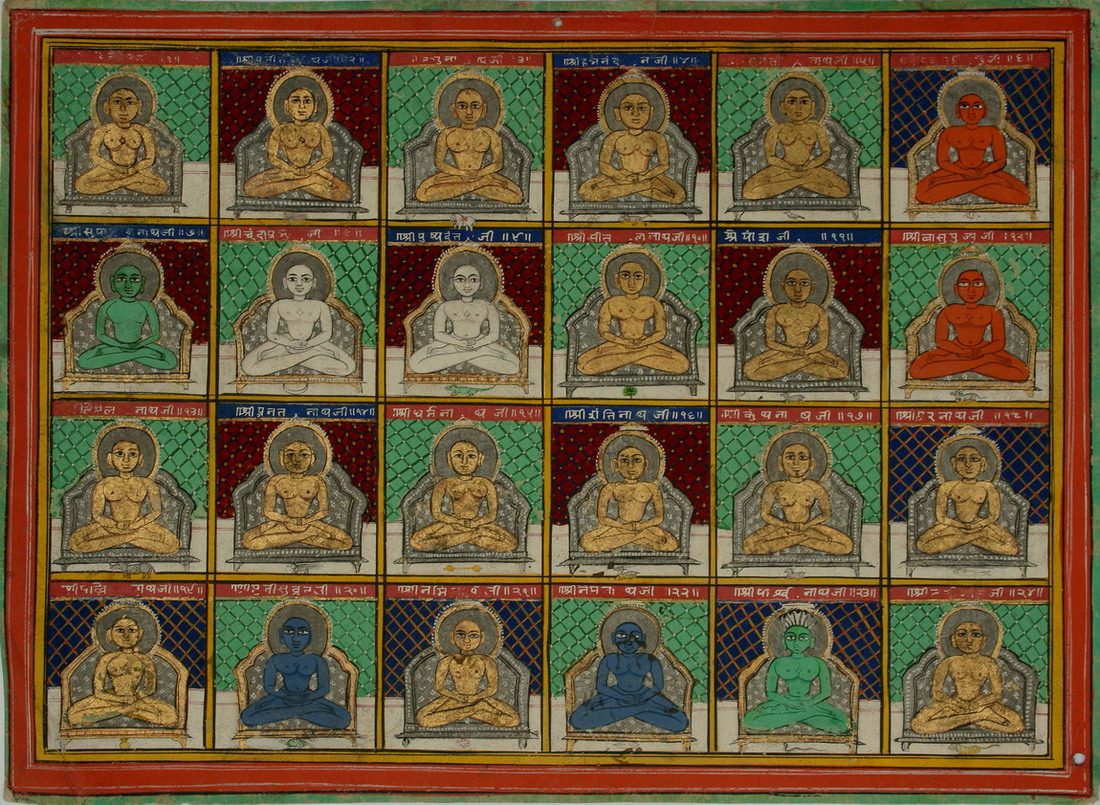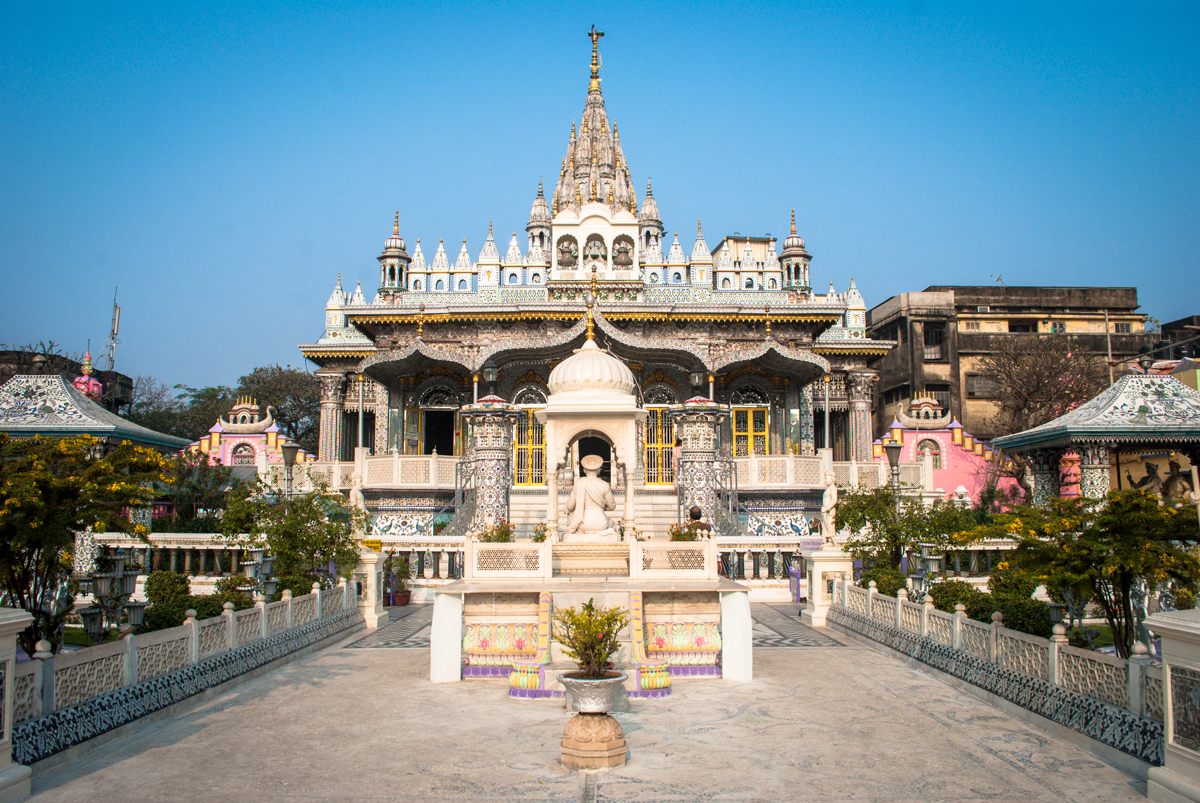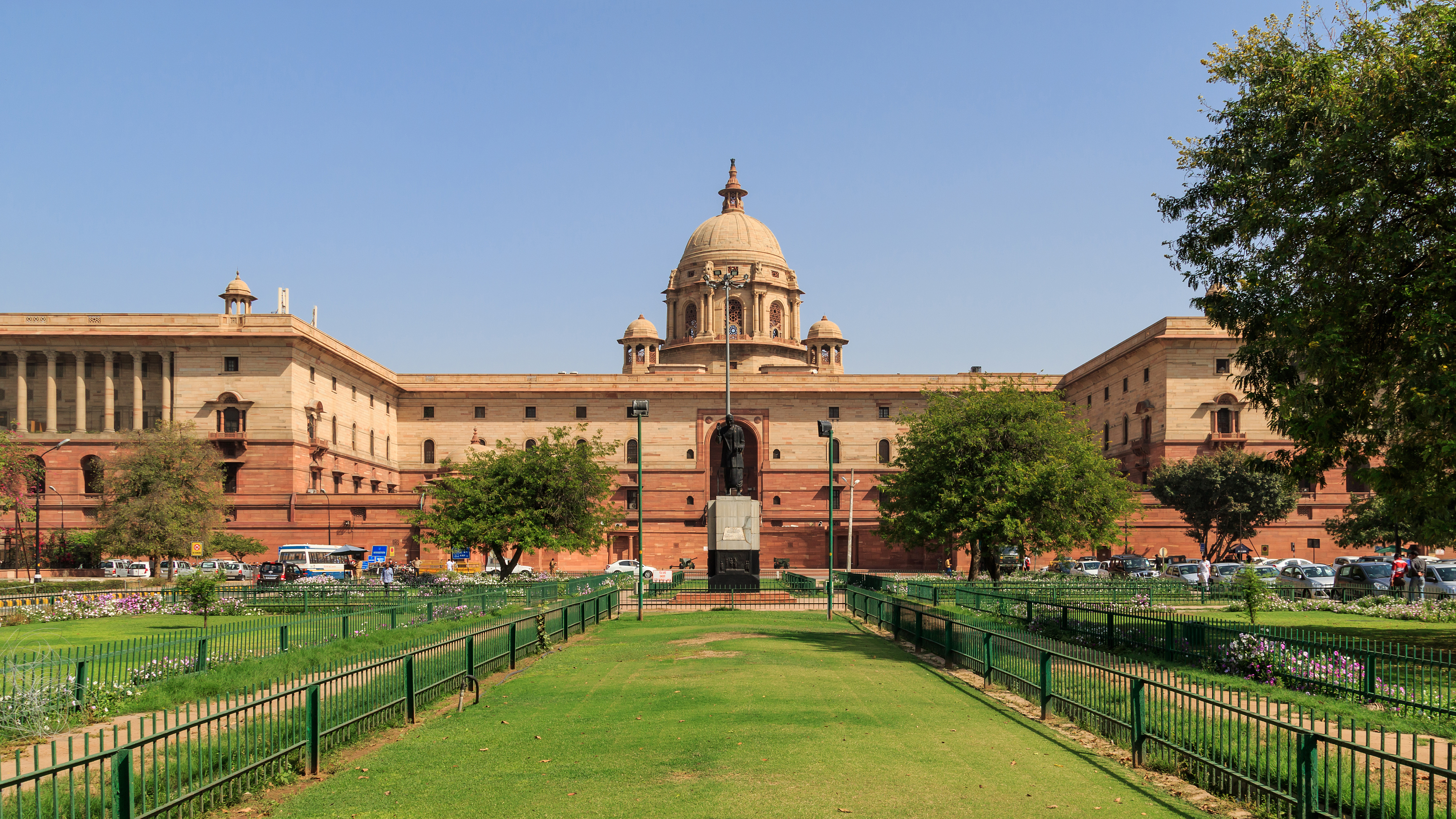|
Shitalnath
Shitalanatha was the tenth tirthankara of the present age according to Jainism. According to Jain beliefs, he became a siddha, a liberated soul which has destroyed all of its karma. Jains believe Shitalanatha was born to King Dradhrath and Queen Nanda at Bhaddilpur into the Ikshvaku dynasty. His birth date was the twelfth day of the Magha Krishna month of the Indian national calendar. Shitalanatha is associated with Svastika (Dig.)/ Srivatasa (Svet.) emblem, Pilurikha tree, Brahma Yaksha and Manavi (Dig.) & Ashoka (Svet.) Yakshi. Biography Shitalanatha was the tenth tirthankara of the present age according to Jainism. According to Jain beliefs, he became a siddha, a liberated soul which has destroyed all of its karma. Jains believe Shitalanatha was born to King Dradhrath and Queen Nanda at Bhaddilpur into the Ikshvaku dynasty. His birth date was the twelfth day of the Magha Krishna month of the Indian national calendar. Shitalanatha is associated with Svastika (Dig.)/ Srivatas ... [...More Info...] [...Related Items...] OR: [Wikipedia] [Google] [Baidu] |
Ikshvaku Dynasty
The Solar dynasty (IAST: Suryavaṃśa or Ravivaṃśa in Sanskrit) or the Ikshvaku dynasty was founded by the legendary king Ikshvaku.Geography of Rigvedic India, M.L. Bhargava, Lucknow 1964, pp. 15-18, 46-49, 92-98, 100-/1, 136 The dynasty is also known as ("Solar dynasty" or "Descendants of the Sun") which means that this dynasty prays to the Sun as their God and their originator (the Gayatri Mantra is a prayer offered to the Sun God as the Sun is the main deity of the Solar Dynasty), and along with Lunar dynasty comprises one of the main lineages of the Kshatriya Varna. The first ''Tirthankara'' of Jainism, Rishabhdeva himself was King Ikshvaku. Further, 21 Tirthankaras of Jainism were born in this dynasty. According to Buddhist texts and tradition, Gautama Buddha descended from this dynasty. Many later kings of the Indian subcontinent claimed to be of Suryavamsha descent. The important personalities belonging to this royal house are Mandhatri, Muchukunda, Amba ... [...More Info...] [...Related Items...] OR: [Wikipedia] [Google] [Baidu] |
Shikharji
Shri Sammet Shikharji () is a pilgrimage site in Giridih district, Jharkhand, India. It is located on Parasnath hill, the highest mountain in the state of Jharkhand. It is the most important Jain Tirtha (pilgrimage site) by both Digambara and Śvētāmbara, for it is the place where twenty of the twenty-four Jain tirthankaras along with many other monks attained Moksha. Etymology ''Shikharji'' means the "venerable peak". The site is also called Sammet Śikhar "peak of concentration." because it is a place where twenty of twenty-four Tirthankaras attained Moksha through meditation. The word "Parasnath" is derived from Parshvanatha, the twenty-third Jain Tirthankara, who was one of those who is believed to have attained Moksha at the site. Geography Shikarji is located in an inland part of rural east India. It lies on NH-2, the Delhi-Kolkata highway in a section called the Grand Trunk road Shikharji rises to making it the highest mountain in Jharkhand state. Jain tradi ... [...More Info...] [...Related Items...] OR: [Wikipedia] [Google] [Baidu] |
Madhuban
Madhuban is a small area of Jorhat City and is under Jorhat municipality Board, Assam, India. The only road that passes through Madhubon is the Madhuban Path. It connects two important roads of Jorhat; Malow Ali and Choladhara road. Madhuban is about 1.5 km far from the ASTC Bus Station, Jorhat and Jorhat Court. Famous Temple Shitalanatha Temple This temple is dedicated to Shitalanatha, tenth tirthankar of Jainism. Padmaprabha Temple This temple is dedicated to Padmaprabha, sixth tirthankar of Jainism. Moolnayak of this temple is a black colored idol of Padmaprabha Brahma Kumaris Madhuban can also refer to the Brahma Kumaris ashram in Mount Abu, Rajasthan Rajasthan (; lit. 'Land of Kings') is a state in northern India. It covers or 10.4 per cent of India's total geographical area. It is the largest Indian state by area and the seventh largest by population. It is on India's northwestern s .... Located in the Araveli mountains is the hill station of Mount Abu ... [...More Info...] [...Related Items...] OR: [Wikipedia] [Google] [Baidu] |
Tirthankara
In Jainism, a ''Tirthankara'' (Sanskrit: '; English language, English: literally a 'Ford (crossing), ford-maker') is a saviour and spiritual teacher of the ''Dharma (Jainism), dharma'' (righteous path). The word ''tirthankara'' signifies the founder of a ''Tirtha (Jainism), tirtha'', which is a fordable passage across the sea of interminable births and deaths, the ''Saṃsāra (Jainism), saṃsāra''. According to Jains, a ''Tirthankara'' is an individual who has conquered the ''saṃsāra'', the cycle of death and rebirth, on their own, and made a path for others to follow. After understanding the true nature of the self or soul, the ''Tīrthaṅkara'' attains ''Kevala Jnana'' (omniscience). Tirthankara provides a bridge for others to follow the new teacher from ''saṃsāra'' to ''moksha'' (liberation). In Jain cosmology, the wheel of time is divided in two halves, Utsarpiṇī' or ascending time cycle and ''avasarpiṇī'', the descending time cycle (said to be current no ... [...More Info...] [...Related Items...] OR: [Wikipedia] [Google] [Baidu] |
Jainism In Bengal
Archaeological evidence shows Jainism was a significant religion in Bengal during the early historic period. Sarak Saraks are a Jain community in Bihar, Bengal, Orissa and Jharkhand. They have been followers of Jainism since ancient times; however, they were isolated and separated from the main body of the Jain community in western, northern and southern India. According to Ramesh Chandra Majumder, the Jain scholar Bhadrabahu, the second Louhacharya and the author of Kalpa Sutra may have come from the Sarak community. The Saraks were agriculturists and moneylenders having landed properties. They have continued to remain vegetarian even though this practice is uncommon among other communities in the region. Saraks have Parshva as a favored patron and recite the Ṇamōkāra mantra. The 24th Tirthankara Mahavira visited this region according to the Kalpa Sūtra. The Saraks lost contact with Jains in the rest of India after its conquest by Ikhtiyar Uddin Muhammad bin Bakhtiyar ... [...More Info...] [...Related Items...] OR: [Wikipedia] [Google] [Baidu] |
New Delhi
New Delhi (, , ''Naī Dillī'') is the Capital city, capital of India and a part of the NCT Delhi, National Capital Territory of Delhi (NCT). New Delhi is the seat of all three branches of the government of India, hosting the Rashtrapati Bhavan, Parliament House (India), Parliament House, and the Supreme Court of India. New Delhi is a Municipal governance in India, municipality within the NCT, administered by the New Delhi Municipal Council, NDMC, which covers mostly Lutyens' Delhi and a few adjacent areas. The municipal area is part of a larger List of districts in India, administrative district, the New Delhi district. Although colloquially ''Delhi'' and ''New Delhi'' are used interchangeably to refer to the National Capital Territory of Delhi, both are distinct entities, with both the municipality and the New Delhi district forming a relatively small part of the megacity of Delhi. The National Capital Region (India), National Capital Region is a much larger entity compri ... [...More Info...] [...Related Items...] OR: [Wikipedia] [Google] [Baidu] |
Government Of India
The Government of India ( ISO: ; often abbreviated as GoI), known as the Union Government or Central Government but often simply as the Centre, is the national government of the Republic of India, a federal democracy located in South Asia, consisting of 28 union states and eight union territories. Under the Constitution, there are three primary branches of government: the legislative, the executive and the judiciary, whose powers are vested in a bicameral Parliament, President, aided by the Council of Ministers, and the Supreme Court respectively. Through judicial evolution, the Parliament has lost its sovereignty as its amendments to the Constitution are subject to judicial intervention. Judicial appointments in India are unique in that the executive or legislature have negligible say. Etymology and history The Government of India Act 1833, passed by the British parliament, is the first such act of law with the epithet "Government of India". Basic structure The ... [...More Info...] [...Related Items...] OR: [Wikipedia] [Google] [Baidu] |
Ministry Of Information And Broadcasting (India)
Ministry of Information and Broadcasting (Ministry of I&B) is a ministerial level agency of the Government of India responsible for the formulation and administration of rules, regulations and laws in the areas of information, broadcasting, the press and the Cinema of India. The Ministry is responsible for the administration of Prasar Bharati, the broadcasting arm of the Indian Government. The Central Board of Film Certification is the other important statutory body under this ministry being responsible for the regulation of motion pictures broadcast in India. Organisation * Broadcasting ** Conditional Access System (CAS) ** Community Radio Stations ** Prasar Bharati ** Doordarshan ** Akashvani (All India Radio) ** Broadcast Engineering Consultants India Limited ** Uplinking / Downlinking of TV Channels ** Content Regulation on Private TV Channels ** Direct to Home (DTH) ** Internet Protocol Television (IPTV) ** Headend-in-the-Sky (HITS) ** Digital television transitio ... [...More Info...] [...Related Items...] OR: [Wikipedia] [Google] [Baidu] |
Publications Division
To publish is to make content available to the general public.Berne Convention, article 3(3) URL last accessed 2010-05-10.Universal Copyright Convention, Geneva text (1952), article VI . URL last accessed 2010-05-10. While specific use of the term may vary among countries, it is usually applied to text, images, or other content, including paper ( |
Maharaja Sayajirao University Of Baroda
The Maharaja Sayajirao University of Baroda, formerly Baroda College, is a public university in the city of Vadodara, in Gujarat state, India. Originally established as a college in 1881, it became a university in 1949 after the independence of the country. It was later renamed after its benefactor Maharaja Sayajirao Gaekwad III, the former ruler of Baroda State. The university offers undergraduate, post-graduate, and doctoral programs. It houses 89 departments spread over 6 campuses (2 rural and 4 urban) covering 275 acres of land. History The university has its origins in the Baroda College, established in 1881 by Baroda State. The main building, which houses the Faculty of Arts, was designed by Robert Fellowes Chisholm in Indo-Saracenic architecture style, in a fusion of Indian and Byzantine arches and domes in brick and polychrome stone. The main dome on the convocation hall was modelled after the great dome of the Gol Gumbaz in Bijapur. Pratap Singh Gaekwad of Baroda ( ... [...More Info...] [...Related Items...] OR: [Wikipedia] [Google] [Baidu] |
Jainism And Non-creationism
According to Jain doctrine, the universe and its constituents—soul, matter, space, time, and principles of motion—have always existed. Jainism does not support belief in a creator deity. All the constituents and actions are governed by universal natural laws. It is not possible to create matter out of nothing and hence the sum total of matter in the universe remains the same (similar to law of conservation of mass). Jain texts claim that the universe consists of ''jiva'' (life force or souls) and '' ajiva'' (lifeless objects). The soul of each living being is unique and uncreated and has existed during beginningless time. The Jain theory of causation holds that a cause and its effect are always identical in nature and hence a conscious and immaterial entity like God cannot create a material entity like the universe. Furthermore, according to the Jain concept of divinity, any soul who destroys its ''karmas'' and desires achieves liberation ( ''nirvana''). A soul who destr ... [...More Info...] [...Related Items...] OR: [Wikipedia] [Google] [Baidu] |
Arihant (Jainism)
''Arihant'' ( pka, arihant, italic=yes, sa, अरिहन्त, lit=conqueror) is a jiva (soul) who has conquered inner passions such as attachment, anger, pride and greed. Having destroyed four inimical karmas, they realize pure self. ''Arihants'' are also called ''kevalins'' ( omniscient beings) as they possess '' kevala jnana'' (pure infinite knowledge). An ''arihant'' is also called a ''jina'' ("victor"). At the end of their life, ''arihants'' destroy remaining ''karmas'' and attain ''moksha'' (liberation) and become '' siddhas''. ''Arihantas'' have a body while ''siddhas'' are bodiless pure spirit. The Ṇamōkāra mantra, the fundamental prayer dedicated to ''Pañca-Parameṣṭhi'' (five supreme beings), begins with ''Ṇamō arihantāṇaṁ'', "obeisance to the arihants". ''Kevalins'' - omniscient beings - are said to be of two kinds # ''Tirthankara kevalī'': 24 human spiritual guides who after attaining omniscience teach the path to salvation. # ''Sāmānya ... [...More Info...] [...Related Items...] OR: [Wikipedia] [Google] [Baidu] |






.jpg)


